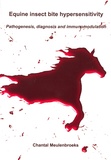Equine insect bite hypersensitivity
Pathogenesis, diagnosis and immunomodulation

Meulenbroeks, Chantal
- Promoter:
- Prof.dr. T. (Ton) Willemse & prof.dr. V.P.M.G. (Victor) Rutten
- Co-promoter:
- Dr. D.M.W. (Dietmar) Zaiss
- Research group:
- Rutten
- Date:
- January 5, 2016
- Time:
- 16:15 h
Summary
Insect bite hypersensitivity (IBH) is a seasonal allergic dermatitis primarily caused by Culicoides midges like C. obsoletus. The welfare of IBH-affected horses is compromised due to severe itch with secondary dermatitis and skin infections. Similar to most allergies, IBH can only be controlled rather than permanently cured. The research described in his thesis aimed at better understanding of the immunopathogenesis as a basis to improve diagnosis and to explore potential immune modulatory strategies for IBH. Horses with IBH, living in a C. obsoletus-rich environment, appear to have much more IgE antibodies against C. obsoletus proteins compared to C. sonorensis and C. nubeculosus proteins. In these environments a C. obsoletus-specific IgE ELISA can be routinely used to diagnose IBH throughout the year. In addition, IgG(T) may be considered as an additional diagnostic marker for IBH in the IBH-season. It was shown that IBH-affected animals have a Th2-skewed immune response against Culicoides-specific antigens. Moreover, animals without IBH, in contrast to the so far established dogma, are not ignorant of Culicoides-specific antigens, but have a Th1-skewed immune response. Such response may protect them against an allergic reaction and hence IBH-associated symptoms. Two C. obsoletus complex recombinant allergens pools, P1 (Cul o 1, Cul o 2 and Cul o 5) and P2 (Cul o 3, Cul o 5 and Cul o 7) were able to stimulate antigen-specific Th1 and IL-10 producing Treg cells in prolonged T cell cultures from IBH-affected animals in vitro. Therefore, it would be interesting to investigate these recombinant allergens in vivo for immunotherapy in combination with adjuvants. Finally, we discovered that basophils can enhance the suppressive capacity of local Treg cell populations by producing and releasing amphiregulin after UVB irradiation in mouse skin. However, our pilot study in horses showed no indications for a beneficial effect of UVB-irradiation on IBH skin by amphiregulin-mediated immunosuppression under the present experimental conditions. More research needs to be done to find out whether or not UVB irradiation may be a complimentary treatment for horses with IBH.